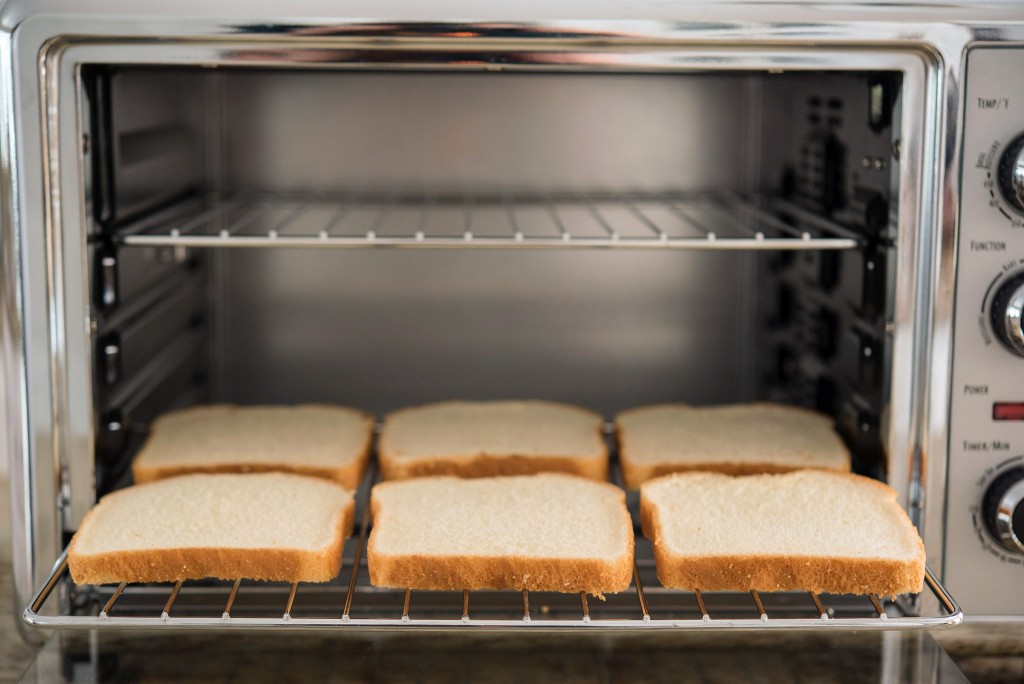Before we began testing toaster ovens, we had many lengthy discussions about what would be the best food products to use. After considering our own experiences using a variety of kitchen appliances, scouring user reviews, and asking anybody who would lend an ear, we believe we came up with a list of testing foods that covers the full gamut of things users want to make in a toaster oven.
We broke our testing down into four main metrics. Three of them—Toasting Performance, Cooking Performance, and Temperature Accuracy—focus on cooking quality. Our Ease of Use metric considers how simple each model is to use and whether or not they have the propensity to induce hunger-driven temper tantrums.
Cooking Performance
To determine cooking performance, we used frozen pizzas, cookies, meatballs, and tater tots. We made pizza in each model and graded them on how close they came to the ideal crispy on the outside yet chewy on the inside crust, how well the dough at the center was cooked, whether or not the cheese was fully melted, and if the pepperonis were just starting to crisp around the edges. For most models, we used a 12-inch pizza that was half cheese and half pepperoni so we could easily assess the quality of both toppings. Some of the toaster ovens like the Panasonic FlashXpress, the Hamilton Beach 2-in-1 31156, the Hamilton Beach Easy Reach 4-Slice, and the Black+Decker 4-Slice TO1313SBD can only accommodate a 9-inch pizzas. We had trouble finding 9-inch frozen pizzas in any of our local supermarkets, so we made a few 6-inch pepperoni pizzas and a few 6-inch cheese pizzas. For tater tots, we looked for crispy outsides and fluffy insides.
In the interest of consistency, we used store-bought cookie dough and followed the cookie manufacturer's baking instructions. We graded all of the cookies based on the evenness of cooking and level of moisture. We specifically wanted cookies with just a bit of crunch on the outside with insides that were just a bit gooey.
Toasting Performance
A toaster oven loses a lot of versatility points if it can't make decent toast. In our testing, we made toast in each model on the medium shade setting using each oven's toast mode. We then evaluated the resulting toast for evenness and taste/texture. The ideal piece of toast would have an even level of browning across the face of the toast, and both sides of the toast would be identical. This is nearly impossible for a toaster oven to achieve because the rack inevitably leaves odd marks on the toast. However, some models were able to achieve high marks for their bread-toasting ability.
The ideal oven would have perfectly consistent heat throughout the entirety of its cooking chamber. In reality, ovens are inevitably going to lose some heat through their walls, thus the outer portions of the oven will be slightly cooler than the middle. This is not an issue for most baked goods, as they would be placed in the center of the oven anyway. However, toast is one item you might ram to capacity in a toaster oven, especially in smaller ovens, or if you're hosting a big brunch party. Each oven has a toasting sweet spot in the center, and bits around the edge where bread won't get toasted as much. To test this, we made toast maps by packing the toaster full and placing bread all the way to the edges of the toasting rack. This revealed the size of each model's toasting sweet spot and showed whether bread near the edges would be neglected.
Ease of Use
Apart from how easy it is to remove and clean the crumb tray, ease of use for toaster ovens mostly boils down to how simple it is to navigate through the plethora of functions. To assess this, we held the inaugural toaster oven Olympics in our office. Participants were given a list of many things to do on each oven, including but not limited to changing between modes before and after starting a cook cycle, adjusting temperature and time in the middle of a cook cycle, turning convention on and off, and of course, cleaning the crumb tray. All of the participants then bestowed a grade upon each model based on how easily they were able to complete all of the tasks.
Temperature Accuracy
In order to test temperature accuracy, we purchased two of the most highly regarded oven thermometers. We found that these thermometers never differed from one another by more than 5˚, so we felt confident in their accuracy. We put these thermometers in each oven, set the temperature to 350 degrees Fahrenheit, and tracked their temperatures for thirty minutes, logging the temp every six seconds and gathering thousands of data points. We repeated this test 3 times and logged the average standard temperature deviations, uncovering which toaster ovens ran hot, which ran cool, and which stayed truest to their set temps.
We also measured how long each oven took to preheat to 350F, again taking three measurements and using the average of the three. The fastest models were usually those with smaller interiors, while cavernous ovens took the longest.





